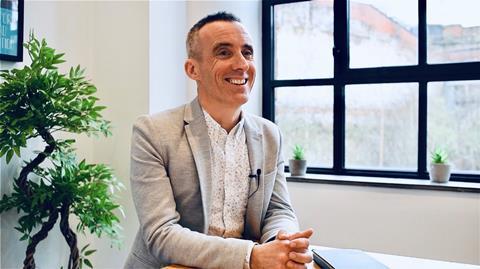Profession criticises lack of detail in long-awaited plans
Architects have warned Michael Gove’s levelling up white paper does not provide enough clarity and ambition to achieve its aims.
The paper, published yesterday, sets out 12 “missions” to level up the UK and reverse decline in some parts of the country.
It proposes allocating the bulk of a previously announced £1.8bn brownfield fund towards regenerating 20 places, including Wolverhampton and Sheffield, with a focus on derelict sites, along with changes to ensure a higher proportion of housing grant goes to the north and Midlands.
Ministers are pledging that by 2030 every part of England that wants one will have a London-style devolution settlement.
Other missions to be met by 2030 are around research and development investment, employment and productivity, public transport connectivity, broadband availability, education, skills, life expectancy, well-being and crime.

But many questioned whether the plan was ambitious enough and queried the lack of detail about how the 12 missions will work in practice.
Hana Loftus, founding co-director of Colchester-based architect Hat Projects who has also worked as a planner with South Cambridgeshire council, said: “The white paper is hugely ambitious, and this isn’t yet matched by the funding or mechanisms to deliver.
“It will be a real test of Gove’s influence and staying power, as it requires a level of whole system change that is both alien to Whitehall and time-consuming to deliver.
“In the meantime, look out for low-budget, high-impact projects being fast-tracked in order to show short-term visible improvements, boosting electoral prospects in marginal seats.”
Ivan Harbour, senior design partner at Rogers Stirk Harbour & Partners said: “The UK government needs to do more to encourage levelling up than is set out in the white paper. It needs to give cities and towns real power, locally, so energy for change comes from within. Cities like Bristol, Manchester and London have all thrived with elected mayors.

”Government can certainly help connect cities and towns digitally and physically to themselves and together with others. It can help them address the climate crisis, transportation, affordable living and dynamic business exchange, all paramount in building prosperous communities throughout the UK.”
The white paper got a qualified welcome from John Armitt, chair of the National Infrastructure Commission, who said: “We now have a clearer idea of what the government means by levelling up, and it is ambitious in its scope and aims. We need an equally ambitious implementation programme if we want to achieve tangible change in the space of eight years.
“We welcome steps to broaden devolution to empower more local leaders to develop tailored infrastructure plans as part of their growth strategies. But this needs to be matched by urgent and fundamental reform of how local transport funding is allocated, with a shift from short term funding pots over which councils bid against each other, to long term devolved funding deals.”
Former RIBA president Ben Derbyshire, chair of HTA Design, said: “The electorate will be quick to see through short-term, inevitably superficial, re-allocations of cash with only transient outcomes.
“Regions, towns and cities targeted by this policy have seen cuts that the existing £10bn commitment in no way restores – and the similar sum written off over wasted PPE spending puts the investment into perspective.”
Mark Sitch, senior partner at planning and design consultancy Barton Willmore, said: “A plan for just 20 towns and cities does not match the level of ambition we had been led to expect given how long it has taken to prepare and publish the white paper.”
He added: “Now is the time for genuinely collaborative spatial planning and wider regional strategies. The 12 new ‘missions’ may go some way towards this, but there needs to be more emphasis on joining things up within and between regions.”
His view was echoed by Danny Crump, director of urbanism at Broadway Malyan and a member of the High Streets Task Force. He stressed the need for a holistic approach to spatial and transport planning that would deliver liveable communities on sustainable transport networks and “more bang for the buck for everyone”.
He said he would be watching closely the progress of diverting funding to develop brownfield sites in the north where Broadway Malyan is working on a number of projects with what it calls a “transit-oriented communities approach” to compact urban developments.

He welcomed what he identified as a “promising focus on localism” in the white paper.
“I’m intrigued about the ambition for people to have ‘satisfaction with their town centre’,” he said. “The question is always ‘how do we create authentic communities and inclusive places?’. The solution has to start with people, a process of engagement and co-design, revealing and diagnosing local needs and responding to those.”
But he warned the government that there was a skills gaps in local authorities in terms of delivering well-intentioned but ambitious proposals.
“While cash injections are welcome, it’s vital there is support for local authorities on how to invest this wisely with an eye on viability and delivery. Whether it’s solved through a programme of recruitment, provided by the High Streets Task Force itself or is something Homes England in its new capacity will address, this gap will need bridging if these plans are to deliver.”
Alfonso Padro, principal and director of education at HKS, welcomed the creation of education investment areas but questioned whether the level of funding would be enough to make a meaningful impact.
He added: “Investing in the retention of the best teachers is key, but the learning environment is also extremely important – which means continuing to invest in school buildings and facilities.

“For true levelling up, attention also needs to be paid to alternative provision (AP) and special educational needs and disabilities (SEND) schools as they have on the whole been neglected over the years. It is in the spirit of levelling up that all our young people with challenges are given the same opportunities as everyone else.”
Dominic Gaunt, director of Ayre Chamberlain Gaunt, agreed, saying: “The injection into further education with the proposed elite sixth forms is welcome, but the existing colleges also desperately need some investment after years of underfunding, which could and should drive retrofit nationally.”
He added: ”On the face of it, investment in the skills shortage, infrastructure, social housing and in technology all sounds great, but how different it is to previous pledges remains to be seen.
“It would be good to see some further detail around £26bn commitments outlined for net zero, which seems to be lacking. A net zero and circular economy should be central to capitalise on the benefits this brings more widely to society and complements the levelling up agenda - but I’d question whether 2030 is too late.
“We have work across the country so, despite being based in the south east, I hope that the investment will still offer opportunities for our practice.”
Andrew Jones, cities programme leader of Aecom, said: “While 2030 is setting the stall out for a long-term plan, it doesn’t go far enough to recognise that we need a generational strategy if we are to truly level up the country – the UK is currently the most socially and economically unbalanced nation in Europe.”
He added that to connect people to the best training and employment opportunities levelling up needs to focus on “high quality, mass rapid transit in all city regions and large towns that is integrated with clean, affordable buses and safe streets to walk and cycle”.
Jamie Holmes, chief executive of property tehnology and 3D modelling firm VU.CITY, said: ”After much delay, it’s heartening to see proposals finally being brought forward that will empower local people to revitalise and improve their communities. However, we’d love the government to properly set out how they aim to do this – the paper has little detail on how it will simplify the planning system to make it more accessible”.
Digitisation was key to improving efficiency, speeding up decisions and accelerating the levelling up process to support the revitalisation of towns and cities, he said, adding: ”New development and infrastructure are absolutely crucial as we seek to balance opportunities across the country.”
Victoria Hills, chief executive of the RTPI, welcomed support for planning technology and locally set design codes but said they were still waiting for the government’s formal response to last year’s planning white paper and promised comprehensive resources and skills strategy for the sector.
She said support for hybrid online and in-person planning committees would enable a broader cross-section of the public to engage with the system, building on innovation that began in the pandemic.
She called for more local authorities to benefit from the expertise of the High Street Taskforce in areas such as placemaking, planning and design, saying this combined with compulsory purchase order powers for empty shops could help with the regeneration of high streets and town centres.
She added that it was vital the Infrastructure Levy was reformed so that it worked well in all parts of England, including areas with lower land values.
And Simon McWhirter, director of communications, policy & places at the UK Green Building Council, said the white paper was a “missed opportunity” to tackle poor housing.
He said: “A major national home retrofit programme is urgently required to insulate Britain’s left-behind areas from soaring gas prices, and to create tens of thousands of green jobs exactly where they’re most needed.
“Equally disappointing, is that the paper is silent on how government intends to support the two thirds of UK households which are owner-occupied, which need to upgrade their draughty, cold homes.”
Michael Gove’s 12 missions to level up the UK
1. By 2030, pay, employment and productivity will have risen in every area of the UK, with each containing a globally competitive city, with the gap between the top performing and other areas closing.
2. By 2030, domestic public investment in research & development outside the South-east will increase by at least 40% and at least one third over the Spending Review period, with that additional government funding seeking to leverage at least twice as much private sector investment over the long term to stimulate innovation and productivity growth.
3. By 2030, local public transport connectivity across the country will be significantly closer to the standards of London, with improved services, simpler fares and integrated ticketing.
4. By 2030, the UK will have nationwide gigabit-capable broadband and 4G coverage, with 5G coverage for the majority of the population.
5. By 2030, the number of primary school children achieving the expected standard in reading, writing and maths will have significantly increased. In England, this will mean 90% of children will achieve the expected standard, and the percentage of children meeting the expected standard in the worst performing areas will have increased by over a third.
6. By 2030, the number of people successfully completing high-quality skills training will have significantly increased in every area of the UK. In England, this will lead to 200,000 more people successfully completing high-quality skills training annually, driven by 80,000 more people completing courses in the lowest skilled areas.
7. By 2030, the gap in Healthy Life Expectancy (HLE) between local areas where it is highest and lowest will have narrowed, and by 2035 HLE will rise by five years.
8. By 2030, well-being will have improved in every area of the UK, with the gap between top performing and other areas closing.
9. By 2030, pride in place, such as people’s satisfaction with their town centre and engagement in local culture and community, will have risen in every area of the UK, with the gap between the top performing and other areas closing.
10. By 2030, renters will have a secure path to ownership with the number of first-time buyers increasing in all areas; and the government’s ambition is for the number of non-decent rented homes to have fallen by 50%, with the biggest improvements in the lowest performing areas.
11. By 2030, homicide, serious violence, and neighbourhood crime will have fallen, focused on the worst-affected areas.
12. By 2030, every part of England that wants one will have a devolution deal with powers at or approaching the highest level of devolution and a simplified, long-term funding settlement.
Source: Department for Levelling Up, Housing & Communities
















No comments yet